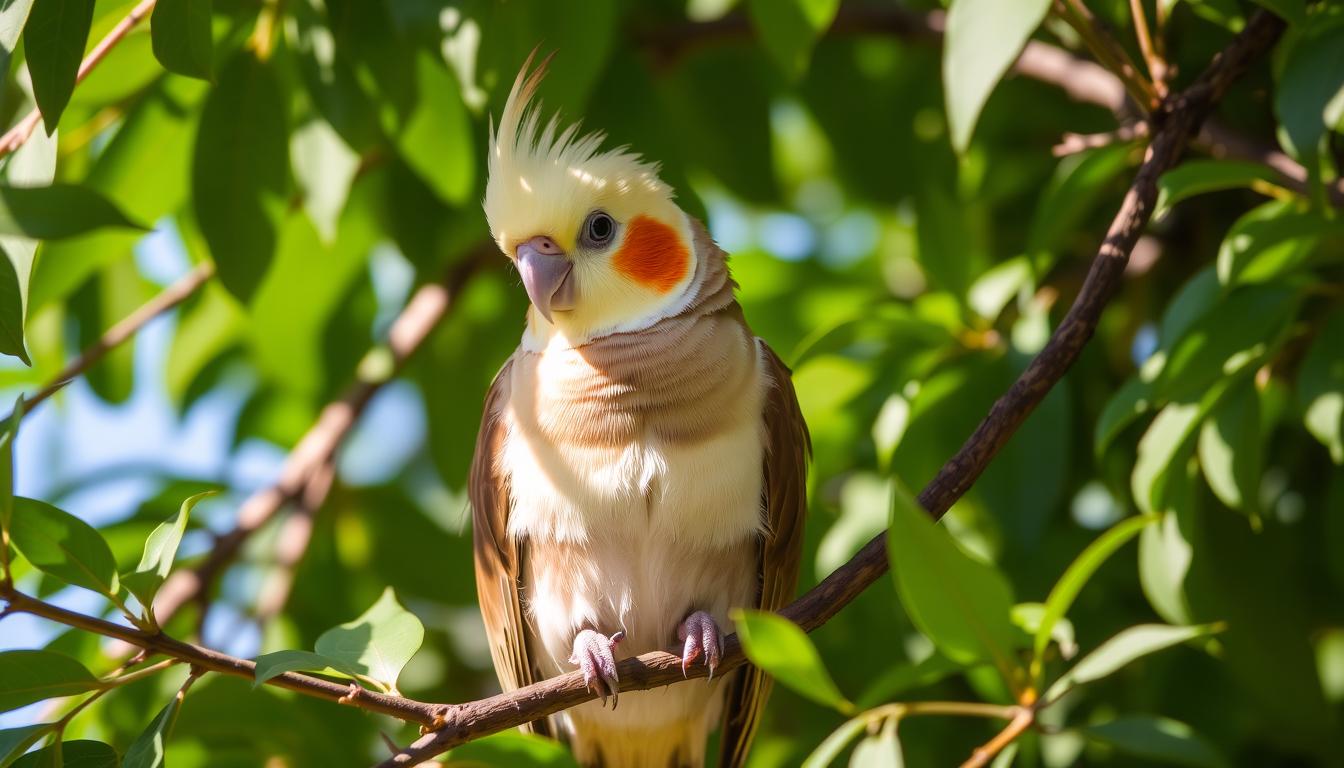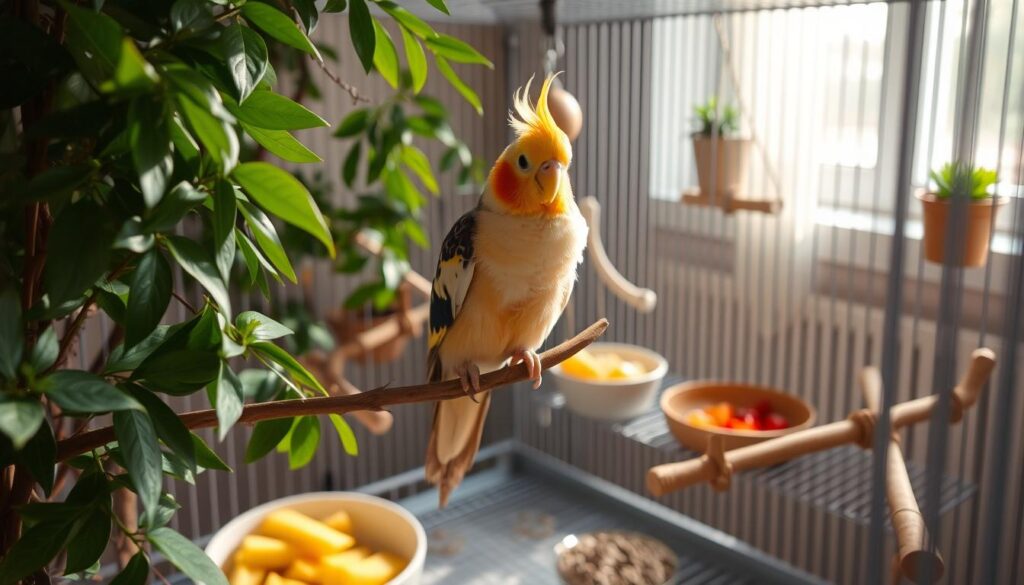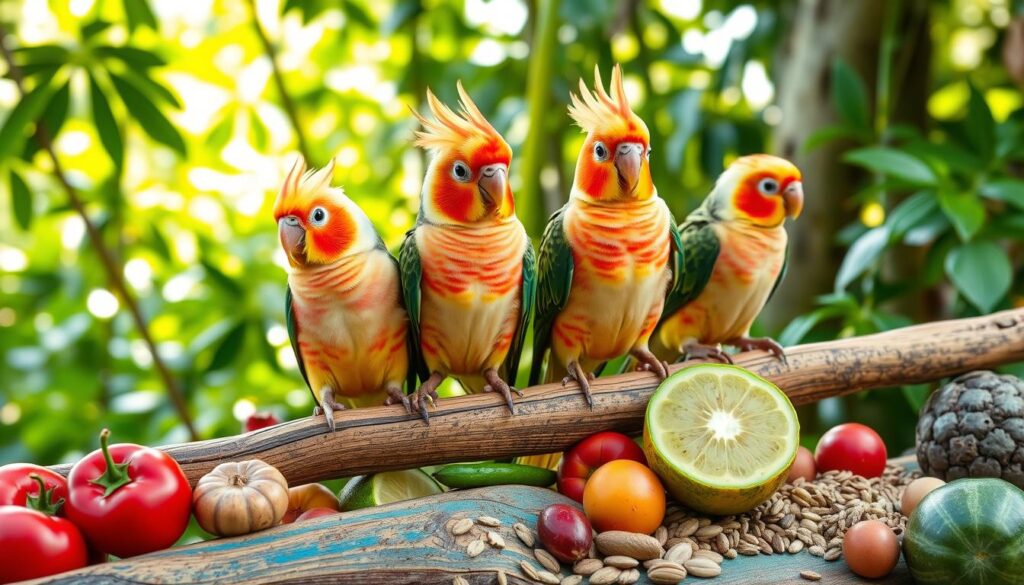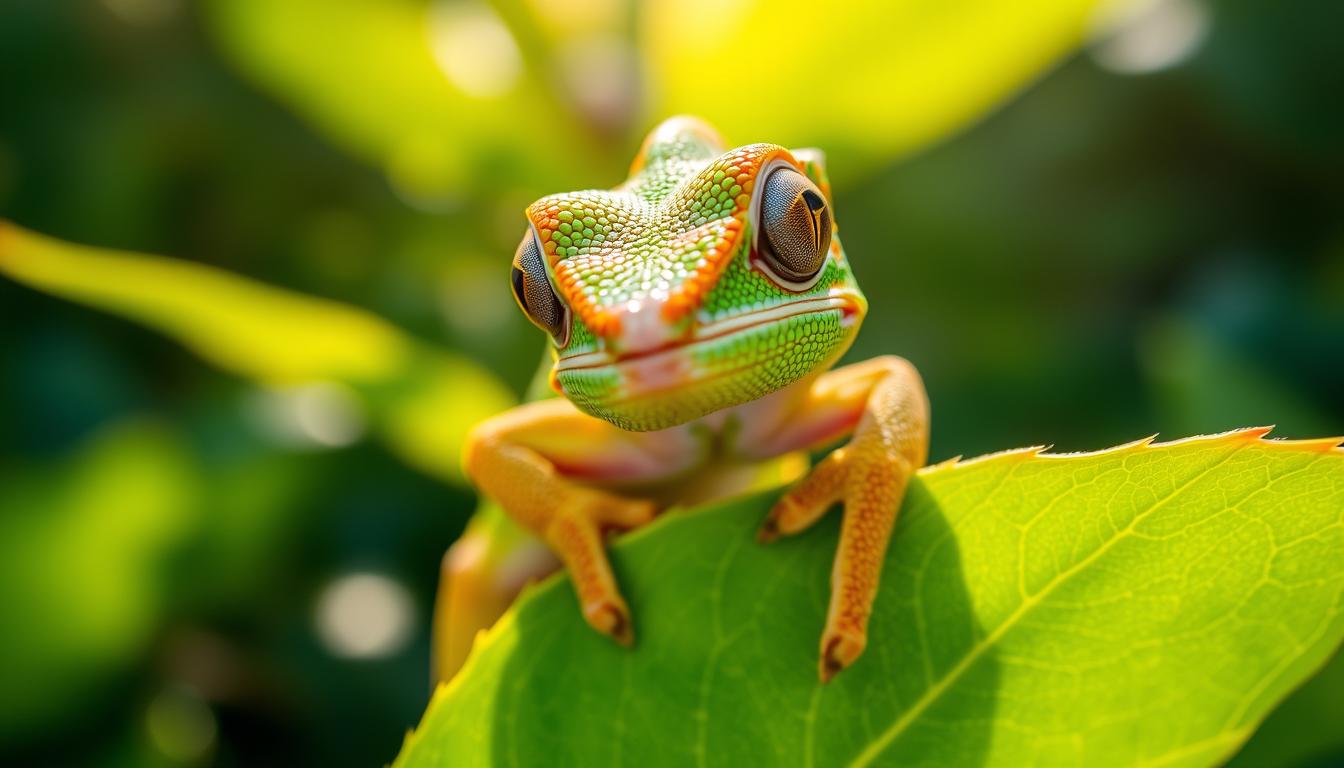Discover the Charm of Cinnamon Cockatiels: A Complete Guide

Thinking about getting a new pet? Cockatiels, including the cinnamon variety, have been popular for years. They first caught European eyes in the late 18th century1. Cinnamon cockatiels stand out with their warm color and charming nature. They’re especially sought after since the 1950s, when the Lutino cockatiel was first recognized2. For more on these birds, check out cinnamon cockatiel information and other pet care topics.
Cockatiels, including cinnamon ones, have become a big part of our culture. They’ve been featured in media and online, and their popularity soared in the 1990s. Today, they’re still loved, thanks to selective breeding that has brought about many color variations2. If you’re thinking of getting one, this guide will help you understand their needs and care.
Key Takeaways
- Cinnamon cockatiels are a unique genetic variation of the cockatiel species, known for their warm, cinnamon-like hue.
- Cockatiels have been a popular pet choice for many years, with their origins dating back to the late 18th century1.
- Cinnamon cockatiels are known for their distinctive appearance and charming personality traits, making them a sought-after pet.
- Cockatiels, including the cinnamon cockatiel, have become a significant part of modern culture, being featured in media and online platforms2.
- Selective breeding has led to an array of color mutations in cockatiels, enhancing their appeal2.
- Cockatiels are native to the Australian continent, predominantly found in the outback regions1.
Understanding the Cinnamon Cockatiel Mutation
The cinnamon cockatiel mutation comes from a recessive gene. It changes how melanin is spread in feathers, leading to cinnamon coloring3. This special coloring makes them a favorite among bird lovers. To get the cinnamon cockatiel mutation, you need to know about their physical traits and color changes.
Cinnamon cockatiels have a warm, cinnamon-colored plumage3. They can also show different colors like pied, silver, and fallow4. These colors mix in different ways, making each bird unique.
Physical Characteristics
Cinnamon cockatiels stand out with their sturdy build and rounded head3. They have medium-length tails and wings, which are usually gray or white. The cinnamon color can range from light golden brown to deep, rich cinnamon4.
Color Variations
Cinnamon cockatiels also come in various colors3. You might see pied, silver, and fallow colors. These mix in different ways, creating a wide range of looks for each bird4.
Distinctive Features
Cinnamon cockatiels have unique traits that make them special3. They are known for their friendly and loving nature. With the right care, they can be great pets, bringing joy and companionship4.
The History and Origin of Cinnamon Cockatiels
Cinnamon cockatiels come from Australia, where they are found in the wild5. They have been bred for their unique colors, including cinnamon5. For more on cinnamon pearl cockatiels, check out cinnamon pearl cockatiel information online.
Cockatiels make great pets, living up to 16-25 years5. They need a good diet and lots of exercise. A balanced diet includes seeds, pellets, fruits, and veggies5. For more on caring for cockatiels, visit pet care websites.
Here are some key facts about cinnamon cockatiels:
- Cinnamon cockatiels are a result of genetic mutation found in captive-bred birds5.
- They are highly social animals and can get bored and lonely if left alone for extended periods5.
- Cockatiels require their wings clipped once or twice a year and nail clippings throughout the year5.
Cinnamon cockatiels are a common color variation, apart from normal grey6. Their cinnamon color comes from a recessive gene. To learn more about cinnamon cockatiels, research cinnamon cockatiel information online.
Personality Traits and Behavior Patterns
Cinnamon cockatiels are playful and loving, forming strong bonds with their owners7. If you’re thinking about getting one, it’s key to know about their social side, smarts, and how they learn. With the right care, they can become wonderful friends.
These birds love to be around people and can get sad if they’re alone too long8. In the wild, they live in big groups. So, make sure to spend time with your cinnamon cockatiel and give them a fun place to be.
Cinnamon cockatiels are very smart, able to learn tricks and even talk9. They can do lots of things if you teach them patiently and kindly. This way, they can show off their cleverness.
Some key traits of cinnamon cockatiels include:
- Playful and affectionate personality
- Highly social and requiring interaction
- Intelligent and capable of learning tricks and mimicking speech
- Requires a stimulating environment and regular engagement
Knowing about cinnamon cockatiels’ unique traits helps you care for them better. With the right care, you can have a deep and joyful connection with your cinnamon cockatiel7.
| Characteristic | Description |
|---|---|
| Social Nature | Requires interaction and companionship |
| Intelligence Level | Highly intelligent, capable of learning tricks and mimicking speech |
| Training Potential | Can be trained with patience, consistency, and positive reinforcement |
Essential Care Requirements

When caring for a cinnamon cockatiel, a balanced diet is key. They need a mix of seeds, pellets, fruits, and veggies for health10. Treats should not make up more than 10% of their daily food10. For more tips, check out the caring for cockatiels guide.
Cinnamon cockatiels also need a big cage for flying. The cage should be at least 24 inches wide10. Clean the cage often, changing cage paper daily and doing a deep clean monthly with safe cleaners10. Regular vet visits are also crucial for their health11.
Some important cinnamon cockatiel care tips include:
- Feed them a variety of fresh foods, including veggies, fruits, grains, and small amounts of cooked proteins11
- Make sure their cage is big and has good air flow12
- Give them toys and activities to keep their minds sharp11
- Keep their cage clean and well-kept10
By following these tips, you can help your cinnamon cockatiel live a happy and healthy life12.
Creating the Perfect Habitat
Creating a perfect habitat is key for your cinnamon cockatiel’s health. A big cage that lets them fly and exercise is a must13. The cage should be at least 24″ wide, with bars no wider than 3/4″13. This ensures a safe and comfy place for them to live.
It’s also vital to give your cockatiel different perches to keep their feet strong13. Food and water dishes should be placed above the perches to avoid mess13. A mix of fruits, veggies, and special bird food is also important for their diet.
To keep things interesting, add toys like swings and bells to the cage13. Regular time outside the cage for socializing and exercise is also crucial. By doing these things, you can make a great home for your cinnamon cockatiel.
- Provide a spacious cage with ample room for flight and exercise
- Include multiple perches of varying diameters and textures
- Offer a balanced diet that includes a variety of fruits, vegetables, and commercially prepared pelleted food
- Provide regular social interaction and exercise outside of the cage
By making a great home and caring for your cockatiel, they can live up to 15-25 years13. With the right care, they’ll be a loving and loyal friend.
Nutrition and Dietary Needs

As a cinnamon cockatiel owner, it’s key to give your bird a balanced diet. A good diet includes seeds, pellets, fruits, and veggies. Seeds should make up no more than 30 percent of their food, and pellets are often best because they’re full of nutrients7. You can find a list of safe foods for cockatiels on cockatielcottage.net, which has lots of info on what to feed them.
When introducing new foods, do it slowly to avoid stomach problems. Foods like avocado, rhubarb, and chocolate are bad for birds and should be avoided14. Treats should only be 20% of their diet, and they should be full of nutrients. Offer fruits and veggies like carrots, sweet potatoes, and leafy greens to give them important vitamins and minerals.
Keeping your cinnamon cockatiel healthy means giving them a varied diet and avoiding harmful foods. This way, your bird can live a long and happy life. Always do your research to make sure you’re giving your bird the best care7.
For more tips on feeding your cinnamon cockatiel, talk to a vet or an avian nutritionist. They can give you advice tailored to your bird’s needs14.
Health Considerations for Cinnamon Cockatiels
As a responsible pet owner, it’s key to focus on your cinnamon cockatiel’s health. With the right cinnamon cockatiel care, they can live up to 25-30 years15. Regular health checks and a clean home are vital to avoid common problems.
Issues like respiratory problems, feather plucking, and bacterial infections can affect them. Keep an eye on your bird’s behavior and watch for signs of illness. This includes changes in appetite, droppings, or breathing16. If you see anything odd, get vet help right away.
Preventive Care Measures
To keep your cinnamon cockatiel healthy, offer a balanced diet and fresh water. Make sure they get regular exercise too. A clean cage and toys help prevent diseases. Also, add a cuttlebone or mineral block to keep their beak trimmed15.
When to Visit an Avian Vet
Regular vet visits are crucial for your cinnamon cockatiel’s health. Schedule yearly check-ups and seek help immediately if you see any illness signs. By focusing on your bird’s health and proper cinnamon cockatiel care, they can live a long, happy life16.
| Health Issue | Symptoms | Treatment |
|---|---|---|
| Respiratory Problems | Wheezing, coughing, difficulty breathing | Antibiotics, respiratory support |
| Feather Plucking | Excessive feather loss, skin irritation | Behavioral modification, medication |
Breeding and Genetics
Understanding the genetics of cinnamon cockatiel breeding is key. These birds are known for their caring nature, making them great for breeding17. The cinnamon color comes from a sex-linked mutation, which means the parents’ genes greatly influence the offspring’s color18.
To breed cinnamon cockatiels, knowing the genetic patterns is crucial. The cinnamon gene is recessive, so a bird needs two copies to show the color19. Breeders use different strategies to get cinnamon offspring, like pairing birds with the right genes17.
Important things to consider in cinnamon cockatiel breeding include:
* Knowing the genetics of the cinnamon mutation18
* Choosing healthy, compatible parents17
* Giving the breeding pair and their chicks the right care and food19
* Being ready for any breeding challenges, like health issues17
By understanding the genetics and following best practices, breeders can raise healthy, colorful cinnamon cockatiels. Whether you’re experienced or new, breeding these birds requires care and attention to detail for the best results18.
| Genetic Mutation | Description |
|---|---|
| Sex-Linked | Includes mutations such as cinnamon, lutino, and pearl17 |
| Recessive | Includes mutations such as pied, whiteface, and fallow19 |
| Dominant | Includes mutations such as dominant silver and pastel face18 |
Cost and Investment Considerations
Thinking about getting a cinnamon cockatiel? You need to look at the upfront cost and what you’ll spend later. The price of these birds can change based on their age, color, and who you buy from20. Generally, you can expect to pay between $80 and $150 for one20.
Yearly costs for food, a place to live, toys, and vet visits can be $280 to $60020. Don’t forget the cost of setting up their home, which can be $150 to $40021. Here’s a quick look at what you might spend:
| Expense | Estimated Cost |
|---|---|
| Initial Purchase Price | $80-$15020 |
| Initial Setup and Supplies | $150-$40021 |
| Annual Food Expenses | $100-$35021 |
| Annual Veterinary Care | $30-$10021 |
Looking at these costs helps you decide if a cinnamon cockatiel is the right pet for you. It also helps you plan to give your new bird the best care22.
Socializing Your Cinnamon Cockatiel
As a cinnamon cockatiel owner, it’s key to know how socialization keeps your bird happy23. It lowers stress and makes your bird’s behavior better. You can socialize your bird by handling them, playing with them, and training them.
To socialize your cinnamon cockatiel, spend quality time together. Do things that help you bond, like:
- Handling and petting
- Playtime with toys
- Training sessions
These actions will make your bird more confident and calm around you23.
It’s also vital to introduce your cinnamon cockatiel to new people, pets, and places. This makes them more social23. You can do this by:
gradually exposing them to new situations and rewarding them for staying calm. With patience and consistency, your cinnamon cockatiel will become a loving friend.
Remember, socializing is a long-term effort that’s crucial for your bird’s happiness23. By following these tips and dedicating time to socializing, you’ll build a strong bond with your feathered friend.
| Activity | Frequency | Duration |
|---|---|---|
| Handling and petting | Daily | 10-15 minutes |
| Playtime with toys | Daily | 30-60 minutes |
| Training sessions | Weekly | 30-60 minutes |
Conclusion: Is a Cinnamon Cockatiel Right for You?
Cinnamon cockatiels can be wonderful and loving pets24. They have bright colors, fun personalities, and love to bond with people2524. They can add a special touch to your home2524.
But, think carefully before getting a cinnamon cockatiel. They need lots of attention every day25. If they’re alone too long, they might get stressed25. They also make a mess with their feathers and poop25.
If you’re ready to give them a loving home, teach them tricks, and adjust your life for them, they could be a great fit. Check out the pet supplies to keep your cinnamon cockatiel happy and healthy.
FAQ
What are the distinctive physical characteristics of cinnamon cockatiels?
What are the different color variations within the cinnamon cockatiel family?
When and how was the cinnamon cockatiel mutation first discovered?
What are the typical personality traits of cinnamon cockatiels?
What are the essential care requirements for cinnamon cockatiels?
How do I create the perfect living environment for a cinnamon cockatiel?
What are the specific dietary needs of cinnamon cockatiels?
What are common health issues that cinnamon cockatiels may face?
What should I consider when breeding cinnamon cockatiels?
How much does it cost to own a cinnamon cockatiel?
How do I properly socialize a cinnamon cockatiel?
Source Links
- https://petnewb.com/origin-and-history-of-cockatiels/ – Origin and History of Cockatiels – Pet Newb
- https://cockatielworld.co.uk/cockatiel-history/ – COCKATIEL HISTORY: An Engaging Journey from Wild to Tamed
- https://www.acstiels.com/sex-linked-and-recessive-mutations – Sex-linked and Recessive Mutations | acstiels
- https://www.kaytee.com/learn-care/pet-birds/cockatiel-colors-the-different-colors – Cockatiel Colors: The Different Colors of Cockatiels
- https://pangovet.com/pet-breeds/birds/cinnamon-cockatiel-bird/ – Cinnamon Cockatiel Bird Species: Info, Personality, Pictures, Diet & Care Guide | PangoVet
- https://kmbreeding.weebly.com/cockatiel-mutations.html – Cockatiel Mutations
- https://www.thesprucepets.com/cockatiels-as-pets-1236728 – Cockatiels: Some of the Most Popular Pet Birds
- https://birdsnways.com/communication/ – Communication And Social Behavior In Cockatiels
- https://animal-world.com/cockatiels/ – Cockatiel Family Varieties | Animal World
- https://myrightbird.com/articles/a-guide-to-understanding-and-caring-for-your-pet-cockatiel – A Guide to Understanding and Caring for Your Pet Cockatiel | myBird
- https://www.buffalobirdnerd.com/storage/app/media/PSPCockatiel.pdf – Microsoft Word – PSPCockatiel2016.doc
- https://vocal.media/petlife/cinnamon-pied-cockatiel – Cinnamon Pied Cockatiel
- https://petadvocacy.org/wp-content/uploads/2022/01/Cockatiel-Care-Sheet.pdf – PDF
- https://www.cockatielcottage.net/tablefoods.html – Cockatiels, Healthy and Nutritious Safe Foods, Safe Fruits, Safe Fruits, Safe Vegetables, Safe Table foods for Cockatiels and Pet Birds. List of Safe Foods, Safe Fruits and Vegetables for Cockatiels and Pet Birds. What foods are safe to feed cockatiels, What do cockatiels eat, What table foods can
- https://animal-world.com/cinnamon-cockatiel/ – Cinnamon Cockatiel: Personality, Facts, Care, & Pictures | Animal World
- https://vcahospitals.com/know-your-pet/cockatiels—general-information – Cockatiels – General Information | VCA Animal Hospitals
- http://www.multiscope.com/hotspot/articles/cockatiel_genetics.htm – Cockatiel Genetics
- https://www.nationalcockatielassociation.co.uk/basic-cockatiel-genetics – BASIC COCKATIEL GENETICS | Nationalcockatielassociation
- http://kmbreeding.weebly.com/cockatiel-genetics.html – Cockatiel Genetics
- https://aviaryescort.com/cost-cockatiel-budget/ – Cockatiel Cost In 2024: Initial & Annual – Aviary Escort
- https://www.hepper.com/how-much-does-it-cost-to-own-a-cockatiel/?srsltid=AfmBOoqQBrtvja_66E3nKcJ7WJ1rGaIl6QaDbOLDMIoFs8k0ZG706y1G – How Much Does a Cockatiel Cost in 2024? One-Time & Recurring Expenses | Hepper
- https://pangovet.com/pet-lifestyle/birds/bird-cost/ – How Much Does a Pet Bird Cost? 2024 Price Guide | PangoVet
- https://parrotjunkie.com/species/cockatiels/?srsltid=AfmBOop2HOSg8h007Hi77o8v12gqQ2piMLJbXwxtv2vqJWXVfth3nlUp – Cockatiels – An Overview of Characteristics and Care – Parrot Junkie
- https://www.parrotforums.com/threads/so-you-want-a-cockatiel.75548/ – So you want a cockatiel?
- https://parrotessentials.co.uk/blog/do-cockatiels-make-good-pets – Do Cockatiels Make Good Pets? 7 Pros and 7 Cons


